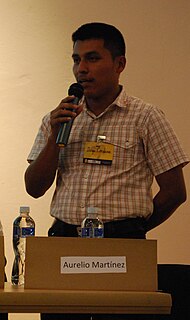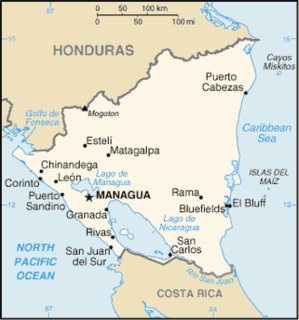Related Research Articles

Central America is a region of the Americas. It is bordered by Mexico to the north, Colombia to the south, the Caribbean Sea to the east, and the Pacific Ocean to the west. Central America consists of seven countries: Belize, Costa Rica, El Salvador, Guatemala, Honduras, Nicaragua, and Panama. Their combined population is estimated at 44.53 million (2016).

The Mosquito Coast, also known as the Miskitu Coast, Mosquito Shore and the Miskitu Kingdom, historically included the kingdom's fluctuating area along the eastern coast of present-day Nicaragua and Honduras. It formed part of the Western Caribbean Zone. It was named after the local Miskitu Nation and was long dominated by British interests. The Mosquito Coast was militarily incorporated into Nicaragua in November 1894; however, in 1960, the northern part was granted to Honduras by the International Court of Justice.

The Nahuas are a group of the indigenous people of Mexico, El Salvador, Guatemala, Honduras, and Nicaragua. They comprise the largest indigenous group in Mexico and second largest in El Salvador. The Aztecs were of Nahua ethnicity, and the Toltecs are often thought to have been as well, though in the pre-Columbian period Nahuas were subdivided into many groups that did not necessarily share a common identity.
Afro–Latin Americans or Black Latin Americans, are Latin Americans of full or mainly African ancestry.

The Miskitus are a native people in Central America. Their territory extends from Cape Camarón, Honduras, to Río Grande de Matagalpa, Nicaragua, along the Mosquito Coast, in the Western Caribbean Zone. Their population is estimated at 700,000 people as of 2021 according to the official Miskitu Database.

Casta is a term which means "lineage" in Spanish and Portuguese and has historically been used as a racial and social identifier. In the context of the Spanish Empire in the Americas it also refers to a now discredited 20th century theoretical framework which postulated that colonial society operated under a hierarchical race-based "caste system". From the outset, colonial Spanish America resulted in widespread intermarriage: unions of Spaniards, Amerindians, and Africans. Basic mixed-race categories that appeared in official colonial documentation were mestizo, generally offspring of a Spaniard and an indigenous person; and mulato, offspring of a Spaniard and a black African. There were a plethora of terms for mixed-race persons of indigenous and African ancestry used in 18th-century casta paintings yet they are not known to have been widely used officially or unofficially in the Spanish Empire.
Latin Americans are the citizens of Latin American countries. Latin American countries and their diasporas are multi-ethnic and multi-racial, Latin Americans are a pan-ethnicity consisting of people of different ethnic and national backgrounds. As a result, some Latin Americans do not take their nationality as an ethnicity, but identify themselves with a combination of their nationality, ethnicity and their ancestral origins. Aside from the indigenous Amerindian population, all Latin Americans have some ancestors who immigrated since 1492. Latin America has the largest diasporas of Spaniards, Portuguese, Black Africans, Italians, Lebanese and Japanese in the world. The region also has large German, French and Jewish diasporas.

Castizo is a racial category used in 18th-century Colonial Spain to refer to people who were three-quarters Spanish by descent and one-quarter Amerindian. The feminine form of the word is castiza. Nowadays the term castizo also came to mean mixed-race people with light skin, in comparison to mulattos, pardos, mestizos and coyotes who would be mixed-race people with dark skin.

Central American Spanish is the general name of the Spanish language dialects spoken in Central America. More precisely, the term refers to the Spanish language as spoken in Costa Rica, El Salvador, Guatemala, Honduras, and Nicaragua. Panamanian Spanish is considered a variety of Caribbean Spanish.

The Mayangna are a people who live on the eastern coasts of Nicaragua and Honduras, an area commonly known as the Mosquito Coast. Their preferred autonym is Mayangna, as the name "Sumo" is a derogatory name historically used by the Miskito people. Their culture is closer to that of the indigenous peoples of Costa Rica, Panama, and Colombia than to the Mesoamerican cultures to the north. The Mayangna inhabited much of the Mosquito Coast in the 16th century. Since then, they have become more marginalized following the emergence of the Miskito as a regional power.

Humberto Akʼabal, also Akʼabʼal or Akabal, was a Kʼicheʼ Maya poet from Guatemala. Akʼabʼal wrote in his native language of Kʼicheʼ, and then translated his poetry into Spanish. With the translations of his works into numerous languages and international recognition, Akʼabʼal is considered to be "the most renowned Maya Kiʼcheʼ poet" in the world and one of the best known Guatemalan writers in Europe and Latin America.

This is a bibliography of selected works about Nicaragua.

Nicoya is a canton in the Guanacaste province of Costa Rica. The head city is in Nicoya district.

Tasbapauni is a seacoast hamlet in Nicaragua, 72 kilometres (45 mi) north of Bluefields. The main ethnic groups are Creole and Miskito.
Usos y costumbres is indigenous customary law in Latin America. Since the era of Spanish colonialism, authorities have recognized local forms of rulership, self governance, and juridical practice, with varying degrees of acceptance and formality. The term is often used in English without translation.
Since the mid-twentieth century, indigenous organizations in Nicaragua have historically formed in response to economic, political, and cultural injustices and to create infrastructure for self-governance. They most often represent their motives and goals as pan-indigenous and do not employ Marxist or Leninist ideas or language of class struggles. Although many organizations stress Miskitu ethnicity, language, and history, most major Nicaraguan indigenous organizations have advocated on behalf of indigenous peoples in general.

Cumbia[ˈkumbja] is a folkloric genre and dance from Colombia.
Conference on Latin American History, (CLAH), founded in 1926, is the professional organization of Latin American historians affiliated with the American Historical Association. It publishes the journal The Hispanic American Historical Review.
Ada Ferrer is a Cuban-American historian. She is Julius Silver Professor of History and Latin American Studies at New York University.

Wealth inequality in Latin America and the Caribbean refers to economic discrepancies among people of the region. Wealth inequality remains a serious issue despite strong economic growth and improved social indicators observed over the past decade. A report release in 2013 by the UN Department of Economic and Social Affairs entitled Inequality Matters. Report of the World Social Situation, observed that: ‘Declines in the wage share have been attributed to the impact of labour-saving technological change and to a general weakening of labour market regulations and institutions. Such declines are likely to affect individuals in the middle and bottom of the income distribution disproportionately, since they rely mostly on labour income.’ In addition, the report noted that ‘highly-unequal land distribution has created social and political tensions and is a source of economic inefficiency, as small landholders frequently lack access to credit and other resources to increase productivity, while big owners may not have had enough incentive to do so.
References
- ↑ Charles R. Hale Worldcat Identities
- ↑ "New Dean Takes Reins" accessed 4 June 2019
- ↑ UCSB Global Studies website https://global.ucsb.edu/people/charles-hale accessed 4 June 2019
- ↑ Latin American Studies Association Past Presidents accessed 4 June 2019
- ↑ “…más que un indio (more than an Indian)”: Racial Ambivalence and Neoliberal Multiculturalism in Guatemala. Santa Fe: School of American Research Press 2006. ISBN 978-1930618602 (Published in Spanish, Guatemala, 2008).
- ↑ Charles R. Hale, Resistance and Contradiction: Miskitu Indians and the Nicaraguan State, 1894-1987. Stanford: Stanford University Press. Santa Fe: School of American Research Press 1994. (Published in Spanish, Guatemala, 2008).